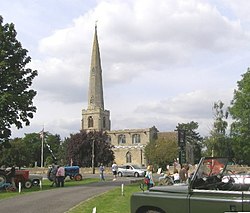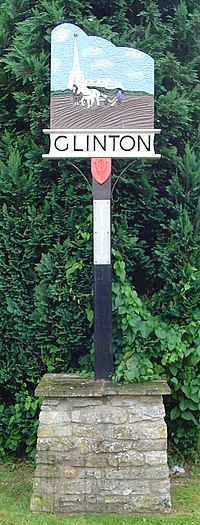Glinton
| Glinton | |
| Northamptonshire | |
|---|---|
 St Benedict's Church, Glinton | |
| Location | |
| Location: | 52°38’20"N, 0°17’42"W |
| Data | |
| Population: | 3,130 (2011) |
| Post town: | Peterborough |
| Postcode: | PE6 |
| Dialling code: | 01733 |
| Local Government | |
| Council: | Peterborough |
Glinton is a village and parish in Northamptonshire, within the Soke of Peterborough, but just outside the city's urban area.
It has a population of 3,130 (2001 Census) and consists of about 1,200 dwellings.[1]
It is separated from the urban sprawl of Peterborough and its New Town suburb of Werrington by the A15, the Peterborough bypass.

The origin of the place name Glinton is uncertain. It may mean "village on the Glym brook" (i.e. the Brook Drain) or could possibly be derived from the Old Danish klint (hill), or Middle Low German glinde (enclosure or fence) or the Old English glente, meaning look-out place.
Glinton was mentioned in the Domesday Book and evidence suggests that it dates from prehistory. There is evidence of early settlement at Glinton, dating back to the Iron Age. Extensive Roman remains, including a beautifully preserved well, were found during construction of the A15 bypass in 1996, as well as a fine example of a mediæval drainage system. Further Roman remains were found in Peakirk Road near the junction with the High Street and it is thought that the area was the site of a Roman farmstead that supplied the larger settlement of Werrington.
The spire of St Benedict's church is considered by many experts[2] to be one of the finest needle spires in England, second only to Salisbury Cathedral. It is the subject of one of John Clare's poems Glinton Spire. Clare, although born in Helpston, went to school in the church, and there is an inscription date 1808 on the door frame of the church.
Glinton has two small shops: a chemist and also a post office/general store. There is a pub (The Bluebell) in the village, the second pub closing in 2006 and becoming a residential property in 2011.
There are two schools in the village: Peakirk cum Glinton, a Church of England primary school with about 200 pupils; and Arthur Mellows Village College, a large secondary school with about 1,700 pupils.
There is also a local football club known as Glinton F.C.
References
- ↑ "Glinton CP (Parish)". Neighbourhood Statistics. Office for National Statistics. http://www.neighbourhood.statistics.gov.uk/dissemination/LeadTableView.do?a=7&b=546100&c=Glinton&d=14&e=16&g=404275&i=1001x1003x1004&o=1&m=0&r=1&s=1319716292391&enc=1&dsFamilyId=75. Retrieved 2011-10-27.
- ↑ Herbert, Ian (2004-12-15). "Poetic justice: villagers defeat phone mast threat by quoting their local bard". The Independent. http://www.independent.co.uk/news/uk/this-britain/poetic-justice-villagers-defeat-phone-mast-threat-by-quoting-their-local-bard-688497.html. Retrieved 2009-11-05.
Outside links
- Glinton.Net A community site for the village of Glinton, including the history of the village, school and church.
- glintonparishcouncil.org.uk The site for Glinton Parish Council

This Northamptonshire article is a stub: help to improve Wikishire by building it up.